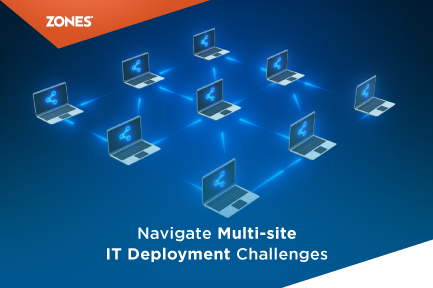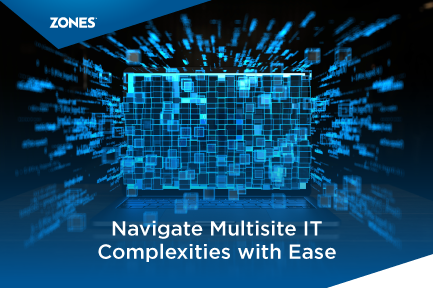7 Tips for Successful Multisite IT Rollouts and Deployments
Today, accelerating globalization, market demands, and competition drive companies' expansion and utilization of multiple offices across cities,...
6 min read
![]() Zones
:
May 27, 2025 9:35:40 AM
Zones
:
May 27, 2025 9:35:40 AM

With the rising digital transformation, implementing new technologies across multiple locations is often the difference between thriving and merely surviving. Multi-site IT deployments come in various forms—each with its unique requirements and complexities:
Whether you're a retail chain deploying contactless payment systems, a healthcare network implementing patient experience technologies, or a financial institution upgrading security infrastructure, the challenges of these multi-location IT rollouts remain surprisingly consistent—and consistently challenging.
According to new Enterprise Strategy Group (ESG) research, nine out of ten surveyed organizations reported that their IT environments have become more complex over the past two years. This complexity creates significant hurdles when rolling out new technologies across distributed locations.
Let's explore the eight most pressing challenges in multi-location IT deployments and how forward-thinking organizations are overcoming them.
The Challenge: Multi-site technology deployments present complex coordination hurdles beyond simple logistics. Maintaining consistent implementation standards across numerous locations with varying layouts, existing infrastructure, and local requirements creates substantial project management complexities. Each location may have different operating hours, unique compliance needs, and site-specific constraints.
Distance makes coordinating procurement, delivery, configuration, and deployment of hardware and software solutions extraordinarily difficult. The challenge intensifies when maintaining consistency and compliance across different branch types and sizes, from flagship locations to small satellite offices.
The Solution: Successful organizations like yours can implement centralized project management frameworks with standardized processes while allowing for necessary local adaptations. This helps establish clear communication channels between headquarters and regional teams and creates detailed implementation playbooks with site-specific variations. Additionally, you can leverage technology to provide real-time visibility into deployment progress across all locations.
The Challenge: Beyond coordination, the equipment's physical movement presents its challenges. Coordinating equipment deliveries and installations across numerous locations creates a logistical maze that can quickly derail project timelines. Each site may require different hardware configurations, have unique receiving constraints, and operate on different schedules.
ESG research shows that 27% of organizations cite the need to incorporate new technologies as a primary driver of IT complexity. When this incorporation must happen simultaneously across multiple sites, the logistics complexity multiplies exponentially.
The Solution: You can implement sophisticated inventory management systems that provide real-time visibility into equipment location and status. You can also develop standardized receiving and staging processes that can be implemented consistently across all locations. By creating detailed delivery schedules aligned with installation resources, your company can minimize on-site storage requirements and reduce the risk of damage or loss.
|
Did You Know Zones’ IntelliPlanSM offers real-time visibility of your asset inventory, demand, shipping, and forecasting to ensure accurate, cost-effective planning and management of your global IT supply chain. |
The Challenge: Most mature organizations have accumulated significant technical debt in the form of legacy systems that vary across locations. Integrating new technologies with these diverse existing systems creates compatibility issues that can derail deployment timelines and compromise functionality.
Whether enterprises are implementing point-of-sale (POS) systems in retail stores, deploying technology devices in healthcare facilities, installing security hardware in banks, or setting up IT infrastructure in public sector offices, seamless integration with existing systems is critical for business continuity.
The Solution: Your organization can conduct thorough pre-deployment assessments at each location to map the existing technology landscape. This enables you to identify potential integration challenges early and develop site-specific strategies to address them. Additionally, adopting middleware solutions that can bridge the gap between legacy systems and new technologies ensures smooth integration while minimizing disruption to operations.
The Challenge: Organizations face heightened security risks during technology rollouts as new systems are implemented and tested. ESG research indicates that 28% of organizations cite the changing cybersecurity landscape as their top complexity driver, making security a critical concern during multi-site deployments.
Whether implementing new IT setups for stores and clinics, managing branch expansions, handling office relocations, or overseeing technology refreshes, each scenario introduces unique security vulnerabilities that must be addressed to ensure seamless new technology implementations in a secure and customizable manner.
The Solution: Industry leaders are implementing comprehensive security protocols for deployment phases. This includes temporary network segregation, enhanced monitoring during transition periods, and phased implementation approaches that limit the attack surface at any given time. This ensures that security considerations are built into every stage of the deployment process, from initial planning to final implementation.
The Challenge: According to ESG, 22% of organizations highlight new data security and privacy regulations as a significant IT challenge. These regulatory requirements can vary dramatically when deploying technology across different regions, creating compliance headaches.
Maintaining consistency and compliance across different branch types and sizes becomes especially challenging when each location may be subject to various regulatory frameworks. Standardizing technology implementations while maintaining compliance requires sophisticated planning for retailers with international locations, healthcare providers operating across state lines, or financial institutions with varying jurisdictional requirements.
The Solution: Build regulatory flexibility into your deployment plans from the outset. You can create modular implementation approaches adapted to regulatory environments while maintaining core functionality and user experience. By developing compliance templates for different regulatory scenarios, your organization can rapidly adapt deployment processes to meet local requirements while ensuring consistent outcomes.
|
Also Read |
The Challenge: Finding qualified IT professionals in all deployment locations is increasingly complex. These skill gaps often lead to inconsistent implementation quality and create dependencies on centralized resources that can delay rollouts.
The demand for skilled IT personnel spikes dramatically during new branch openings, business relocations, or major technology refreshes. Local teams may lack the specialized expertise to configure and deploy advanced technologies, leading to implementation delays, quality issues, and potential security vulnerabilities.
The Solution: Develop standardized, detailed deployment playbooks that reduce the need for advanced technical skills at each location. You can leverage remote deployment technologies that allow central teams to provide real-time guidance to on-site personnel. Additionally, you can partner with specialized service providers who deliver consistent implementation quality across all locations, regardless of local skill availability.
The Challenge: Combining the above factors frequently leads to budget overruns and missed deadlines. These financial and timeline pressures can force organizations to scale back their implementation plans, reducing the value of their technology investments.
Maintaining consistent budgets and timelines across varying location requirements becomes extraordinarily difficult for complex multi-location implementations, such as equipment modernization across retail chains or technology refreshes for healthcare networks. Each deviation compounds, potentially threatening the overall project success.
The Solution: Successful organizations like yours should partner with specialized third-party providers with extensive multi-site deployment experience. These partnerships allow you to leverage proven methodologies, benefit from volume discounts on equipment and services, and access skilled resources across all their locations. They also implement rigorous tracking systems that provide early warnings of potential budget or timeline issues, allowing for proactive intervention before problems escalate.
The Challenge: Organizations with truly global footprints face additional challenges related to language barriers, cultural differences, and varying work practices. These factors can create resistance to change and complicate deployment, adoption, and training efforts.
The Solution: Your organization can involve local stakeholders early in the planning process to ensure cultural considerations are incorporated into deployment strategies. You can create localized training materials and leverage local champions to drive adoption.
As multi-location organizations increasingly recognize the complexity of technology rollouts, more are becoming specialized providers with deep expertise in managing these challenges. Comprehensive IT rollout solutions address the full spectrum of challenges organizations face during multi-location deployments:
Key Components of Effective IT Rollout Solutions:
|
Also Read 9 IT Rollout & Tech Implementation Trends for Multisite Businesses |
With the right implementation partner, organizations can transform complex IT rollouts into streamlined, successful deployments that ensure timely and seamless implementation of new technologies across all locations within budget.
From new IT setups for stores and clinics to branch expansions, office relocations, technology refreshes, and equipment modernization, multi-site technology deployments present complex challenges that require expert handling.
By understanding the common challenges and adopting proven strategies to address them, you can successfully implement new technologies across your operations. The right deployment partner handles the complexity so you can focus on your business growth.
With over thirty years of experience delivering successful IT deployments across diverse industries, Zones has developed a comprehensive approach to managing IT rollout complexities for multi-site businesses. From procurement and logistics coordination to installation, integration, and ongoing management, Zones transforms complex IT rollouts into streamlined, successful deployments.
For a deeper dive into the challenges of multi-location IT rollouts and comprehensive strategies to overcome them, download the exclusive ESG Report: Navigating IT Rollout Complexity With Zones. This in-depth research provides valuable insights for IT leaders managing complex technology deployments across multiple locations.
To learn how Zones can help in your multi-site IT Deployment, visit here: Store and Branch IT Rollout Services | Zones

Today, accelerating globalization, market demands, and competition drive companies' expansion and utilization of multiple offices across cities,...

The evolution of the enterprise IT supply chain tells a compelling story of adaptation and innovation. A decade ago, organizations typically managed...

Climate change and environmental issues are major global challenges. This is why there is a growing recognition to mitigate the environmental impact...